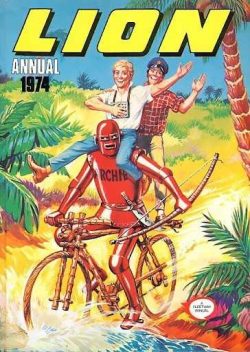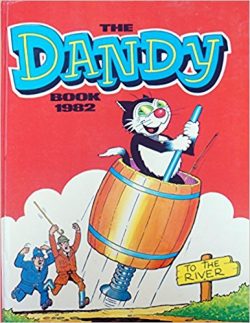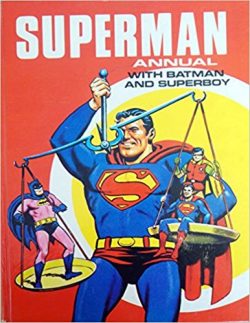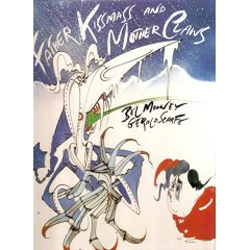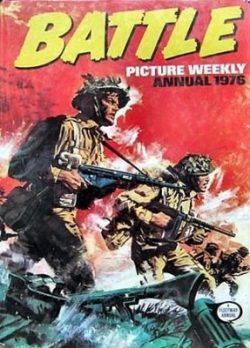
By various (Fleetway)
ISBN: 85037-266-6
For most of the medium’s history British comics have been renowned for the ability to tell a big story in satisfying little instalments which nevertheless left the reader hungry for more. This, coupled with superior creators and the anthological nature of our publications, has ensured hundreds of memorable characters and series have seared themselves into that dim corner inside most British adult males that houses the all-important Little Boys’ Psyche.
One of the last great weekly anthology comics was actually dedicated to a single theme: the all-combat Battle, which launched as Battle Picture Weekly on 8th March 1975, and through the traditional forge of absorption, merger and re-branding (becoming Battle Picture Weekly & Valiant, Battle Action, Battle, Battle Action Force and Battle Storm Force) carved itself a place in British comics history.
It was itself combined with Eagle on January 23rd 1988, after 673 blood-soaked, testosterone-drenched issues, having carved its way into the savage hearts of a generation, consequently producing some of the best and most influential war stories ever.
Annuals began immediately and this forward-dated first volume was released in the autumn of 1975: an action-packed compendium featuring opening salvos of some of the very best creators in Fleetway’s international stable and offering a bonanza of war-tinged fact and fiction features: (presumably) a winning blend of such writers as Pat Mills, John Wagner, Gerry Finley-Day, Tom Tully, Eric and Alan Hebden and artists such as Colin Page, Pat Wright, Giralt, Carlos Ezquerra, Geoff Campion and others I’m not savvy enough to recognise…
The literary and graphic conflict diamonds open with a full-colour text-&-picture spread explaining ‘Crete – The Airborne Invasion’ after which vivid strip vignette ‘Two Pints for the Panzers’ (perhaps painted by Carlos Pino?) details a brief Dunkirk skirmish between a deadly Nazi battlewagon and a few infernally devious Tommies…
A brace of prose recollections entitled ‘This Amazing War – Sailing Home!’ and ‘The Invisible Eye… is Shut!’ neatly proceed into monochrome adventure ‘Petty Officer Perkins’ with a bureaucratic quartermaster accidentally saving a British patrol from Japanese ambush through his small-minded penny-pinching whilst ‘The Escapers: Jail Break’ recounts an amazing true tale of a Mosquito raid to liberate Gestapo prisoners…
Legendary, Dirty Dozen-inspired misfit antiheroes Rat Pack (by Finley-Day and perhaps Fred T. Holmes?) muster next, sinking a docked Italian battleship with their usual gritty overkill, after which ‘Boys At War: A Medal for Badgie – Trumpeter Stanley Waldron, DCM, RFA’ honours in prose the achievements of a remarkable young warrior whilst ‘The Experts: The Sniper’ recounts a forgotten tale of the Anzacs in WWI…
Switching to red and black duo-hues, ‘Brothers in Arms’ reveals how two eternally squabbling heirs to an English Baronial Seat bury their animosity in the forge of combat before ‘This Amazing War – Underwater Strike’ regales the avid readership with an exploit of submarine combat.
Looking like early Eric Bradbury ‘Battle Honour: Sixty Minutes of Glory’ was probably culled from Fleetway’s long-running War Picture Library and detailed the valiant holding action of doomed Merchant cruiser Jervis Bay and is followed by text feature ‘The Escapers: Only One Got Away’ which details the astounding true story of German POW Franz von Werra whom no British, Canadian or American prison could hold…
‘Private War’ then details a clash of wills between supposed allies as a commando and British naval officer put personal animosities ahead of the life and mission of a Coast-Watcher stuck behind Japanese lines before ‘Boys At War: The Youngest Rifleman – Rifleman Ronald Bassett, KRRC’ details the accomplishments of a wilful 15-year-old youngster who enlisted three years too early to fight in WWII…
‘Fun Parade’ offers a wealth of cartoon military mirth whilst ‘Lofty’s One-Man Luftwaffe’ (by Kev O’Neill?) finds the undercover cockney still sabotaging the German Fighter Group he’s flying with as Nazi Air Ace Major Ranke after which ‘The First Great War’ is reviewed in an informative text-&-painted illustration feature.
‘Rogues Gallery’ offers visual insight into enemy aircraft ‘Mitsubishi A6M Type 0 Zero’, ‘Junkers 87 Stuka’, ‘Junkers 88’ and ‘Bachem 349 Viper’ and precedes a fictionalised account of the North African campaign via ‘The Experts: The Long Range Desert Group’ whilst ‘The Seventh Earl’ reveals how members of a group of the Canadian Parachute Battalion on a mission in occupied Holland become entangled in a transatlantic succession battle in England…
Geoff Campion’s classic ‘Private Bolt – a Bad Soldier’ details the grim life, controversial service career and glorious end of a true fighting man and leads off a section of short combat strips, followed in close order by ‘Dutchy’s Battlewagon’ which sees a driver in the Western Sahara teach the Afrika Korps a few lessons about desert warfare and how a D-Day soldier offsets one sensible anxiety against a silly but crippling phobia in ‘One Man’s Fear’…
Text feature ‘The Escapers: The Trojan Horse’ re-examines the mythic tale of POW ingenuity before ‘Tiger Cubb’ (Mike Western) pits Tibetan-trained British boy martial artist Johnny Cubb against sadistic Japanese invaders in China and ‘The Red Knight: Baron Manfred von Richthofen’ blends fact and legend in a biographical strip before the military annals conclude in spectacular fashion with ‘A Game of Bluff’ as British agent and French Resistance fighters unite to uncover a traitor and expedite the D-Day landings…
This bombastic blend of action, tension and drama hasn’t paled in the intervening years and these gripping gems are as powerful and engrossing now as they’ve ever been…
© IPC Magazines Ltd. 1975.




